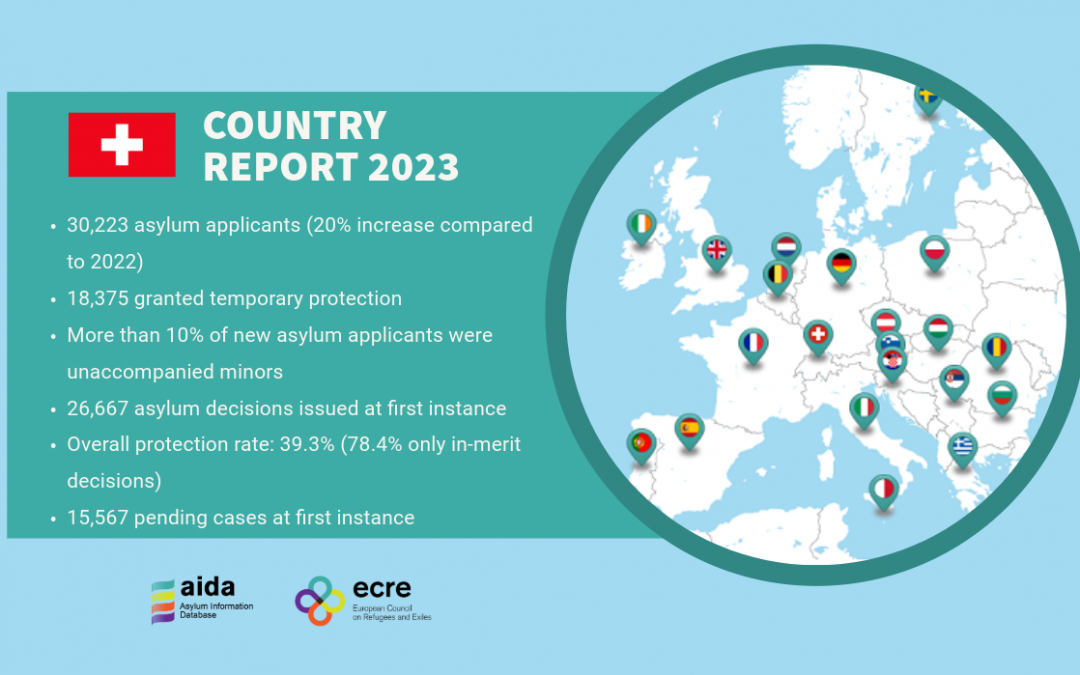The updated AIDA Country Report on Switzerland provides a detailed overview of legislative and practice-related developments in asylum procedures, reception conditions, detention of asylum seekers and content of international protection in 2023. It also includes an annex which provides an overview of temporary protection (TP) (‘Status S’).
In 2023, 30,223 people applied for asylum in Switzerland, an increase of over 20% compared to 2022. The main countries of origin were Afghanistan, Türkiye, Eritrea, Algeria and Morocco. More than 10% of new asylum applicants were unaccompanied minors. The State Secretariat for Migration (SEM) issued 26,667 asylum decisions at first instance. The overall protection rate was 39.3%, rising to 78.4% when only in-merit decisions are considered. There were 15,567 number of pending cases at first instance at the end of 2023. In addition, 23,012 people from Ukraine applied for Status S in Switzerland in 2023 and 18,375 of them were granted it.
Due to the continued high numbers of asylum applications in 2023, the SEM and legal protection actors had to increase their staffing levels. The SEM also introduced several measures to accelerate the asylum procedure for certain categories of applicants, including people from countries of origin with low protection rates, asylum seekers from Afghanistan and unaccompanied minors. The SEM followed the European Union Agency for Asylum’s recommendation and declared that women and girls from Afghanistan could be regarded as refugees. However, in a policy which was supported by the Federal Administrative Court, each claim will still be subject to an individual examination.
The continued high numbers of asylum and TP applicants in 2023 meant that reception facilities at both the federal and the cantonal levels continued to be under pressure throughout 2023 and into early 2024. As the Federal Assembly denied the Federal Council’s application for the financing of additional reception places in containers in the summer of 2023, the SEM had to search for additional reception facilities in collaboration with the army and the cantons. One solution was the use of civil protection bunkers. The National Commission for the Prevention of Torture visited several centres and made a number of recommendations. A shortage of personnel to support asylum seekers living in the centres has also created an additional challenge.
Since the implementation of Status S for people fleeing from Ukraine, a debate about the differential treatment of protection seekers from different countries based on their different legal statuses has opened in Switzerland. An evaluation group coordinated by the Federal Department of Police and Justice is examining the differences between temporary admission status (‘Status F’) and Status S. The Swiss Refugee Council has called for a uniform humanitarian status to replace both Status F and Status S in order to ensure equality of treatment for protection seekers fleeing situations of war. In November 2023, the Federal Council decided against ending Status S before 4 March 2025 unless there is a fundamental change in the situation in Ukraine before then. Nevertheless, the SEM has prepared a concept for the future lifting of Status S.
Finally, the European Court of Human Rights ruled that the financial independence criterion for family reunification for temporarily admitted refugees in Switzerland was too strict. As a result, the individual circumstances of refugees must be given greater consideration.
The full report is available here and the annex on Status S protection is available here.
For more information about the AIDA database or to read other AIDA reports, please visit the AIDA website.

